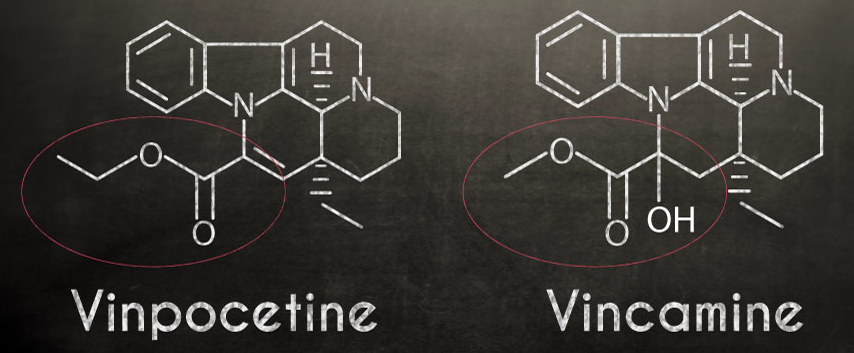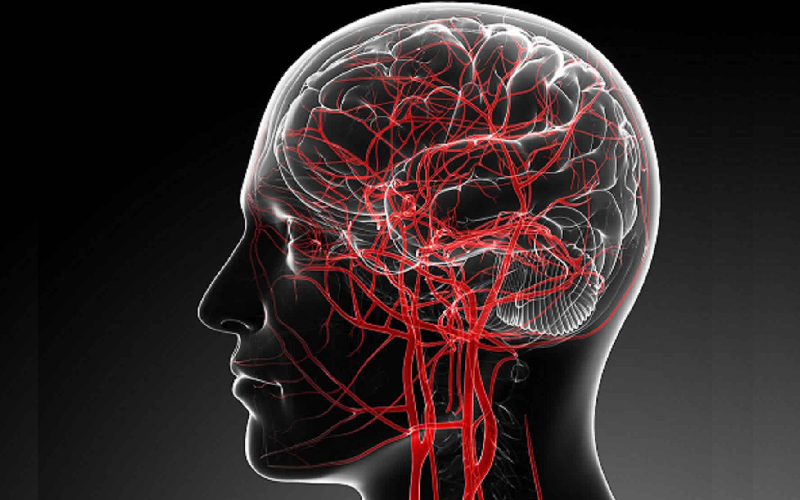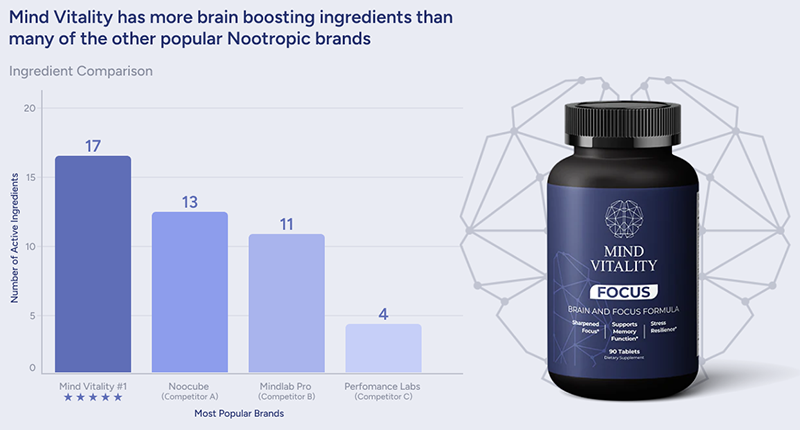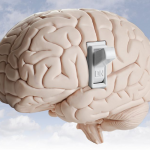Growing old is often accompanied by a decline in cognitive health. Most people associate aging with not just a chronological increase in years living, but also with neurological disorders including dementia, senility, poor memory, stroke, and Alzheimer’s disease. But aging doesn’t have to be accompanied by such neurodegenerative disorders.
Vinpocetine, a derivative of a chemical present in the common periwinkle plant, is a substance well-known in the nootropic community (a nootropic being a substance with cognitive-enhancing properties). Vinpocetine’s main claim to neurological fame is it’s ability to increase brain blood circulation. Increased blood (and thus oxygen) flow in the brain facilitates memory, learning, and other cognitive functions, and also acts as a neuroprotective agent that reduces the likelihood of developing severe cognitive problems during the aging process.
Contents
What Is Vinpocetine?
Alkaloids are a type of plant-based compounds that affect the systems (such as nervous, digestive, or cardiovascular systems) of people. The main active ingredient in the common periwinkle plant is an alkaloid called vincamine. Vinpocetine — the topic of this article — is derived from vincamine. Because it’s “partially synthesized” or “chemically synthesized” from vincamine, vinpocetine is considered a man-made, or semi-synthetic, compound. The process to synthesize vinpocetine actually results in a compound with a higher degree of potency than vincamine.

Vinpocetine, sometimes abbreviated as VPN, and also referred to as vincamine, ceractin, cavinton, Cavinton Forte, or periwinkle extract, was originally developed in Europe and was prescribed there for the treatment of cognitive disorders long before it ever became of interest in the United States. Now vinpocetine is regularly used in the United States to treat these same disorders, and it is also available as a dietary supplement to improve cognitive functions.

What Is Cavinton (Cavinton Forte)?
Cavinton Forte is the brand name of vinpocetine product manufactured by the European pharmaceutical company Gedeon Richter. Cavinton Forte (often referred to as simply Cavinton) is prescribed in much of Europe for treatment of a variety of neurological issues. Unlike in the United States, where vinpocetine is known as just that — vinpocetine — in Europe vinpocetine is usually known as Cavinton.
Cavinton (or Cavinton Forte) is typically sold in tablet form. Such Cavinton tablets are usually 5mg or 10mg each, and sold in boxes of 30, 50, or 90 tablets.
Vinpocetine is the active ingredient in Cavinton Forte, which is why Cavinton Forte is sometimes referred to as vinpocetine, and why vinpocetine is sometimes referred to as Cavinton Forte.
The situation is somewhat akin to Kleenex and tissues. Kleenex is the brand name of a type of tissue. But the Kleenex brand has become so popular and common that we often refer to all brands of tissue as Kleenex, even when it is a different brand.
While the terms vinpocetine and Cavinton or Cavinton Forte are often used interchangeably to mean the same thing, for consistency we’ll always use the word vinpocetine in the remainder of this article.
How Vinpocetine Works
Vinpocetine is a nootropic that works through a variety of pathways, namely lowering inflammation, improving blood circulation, and increasing neuroplasticity. Exactly how vinpocetine works isn’t fully understood, but it does act in a number of different ways to accomplish its effects.
Vinpocetine Acts as An Antioxidant
Free radicals are unstable molecules with an unpaired (odd) number of electrons. Free radicals are formed as a by-product of oxygen interacting with other molecules. While some level of free radicals is normal and healthy, levels that become too high can damage to cells — including damage to cell DNA.
Antioxidants are natural molecules most commonly found in plant foods. Antioxidants are sometimes referred to as free radical scavengers — they search for and collect (scavenge) free radicals. Antioxidants can prevent free radicals from forming and also neutralize existing free radicals.
Vinpocetine carries out significant scavenging activity. By acting as a powerful antioxidant vinpocetine protects cells from the damage typically caused by free radicals. It’s believed that free radicals are critical to cell damage in the brain, and thus play a major role in brain aging and neurodegenerative disorders such as Alzheimer’s disease and Parkinson’s disease. That’s why vinpocetine appears to be beneficial for treating these degenerative neuronal disorders.
Vinpocetine Acts as An Anti-inflammatory
Inflammation is the mechanism where the body’s white blood cells (and the antibodies they make) protect you from the damage invaders like viruses and bacteria cause. While inflammation is generally a good thing (it expels invaders, helps heal injuries, and cleans up afterwards), too much inflammation triggers a whole host of disorders such as asthma, diabetes, arthritis, and blindness.
Cytokines are molecules that enable cells to communicate with each other. They’re also vital for the healthy functioning of the immune system. But, like inflammation, too much leads to bad health outcomes. Too high a level of cytokines can signal an immune response of too much inflammation for too long a time.
Vinpocetine reduces the release of cytokines, which in turn reduces inflammation. Many anti-inflammatory drugs are steroidal and, while effective, are often accompanied by an array of side effects. Nonsteroidal anti-inflammatory drugs (NSAIDs) that are used to treat inflammation (as well as fever and pain) usually present fewer side effects. Vinpocetine is classified as an NSAID.
Vinpocetine Acts as An Antithrombotic
Antithrombotics are compounds that reduce the formation of blood clots. Anticoagulants and antiplatelet drugs are two specific types of antithrombotics. Antithrombotics are sometimes referred to as blood thinners, though they in fact do not actually thin the blood.
There are several prescription medications that are classified as antithrombotic drugs — Warfarin and Heparin are examples of two commonly prescribed medications. There are also more natural compounds that have antithrombotic properties. Vinpocetine falls into this category. Vinpocetine’s ability to slow blood clotting increases blood flow to the brain, which results in protecting neurons (brain cells) from injury.
Vinpocetine Acts as An Antiatherogenic
Atherogenesis is a disease that causes the formation of fatty plaques in the arteries, which can lead to coronary artery disease (CAD) or stroke.
Statins are are a type of drug commonly used as an antiatherogenic — a compound that lowers cholesterol and improve artery health to prevent or inhibit atherogenesis. Vinpocetine is a more natural compound that can also be used as an antiatherogenic. Vinpocetine applies antiatherogenic effects through inhibition of inflammatory response and oxidative stress (free radical damage).
Vinpocetine Acts as An Antiepileptic
An antiepileptic, also referred to as an anticonvulsant, is a compound that is used to stop or prevent convulsions or seizures. Diazepam, Valium, and Clobazam are examples of commonly prescribed antiepileptic medications.
Having the proper concentrations of calcium and sodium ions within cells is necessary for healthy brain communication (and many other processes). Calcium channels and sodium channels are molecular portals that allow for the properly controlled passage of ions across a cell’s membrane. Issues with either of these channels can lead to improper release of excitatory neurotransmitters, which can bring about seizures.
Vinpocetine has been demonstrated to have neuroprotective and anticonvulsant powers. Part of this ability is in vinpocetine’s ability to contribute to properly functioning sodium and calcium channels.
Vinpocetine Provides Brain-Enhancing Anti-Aging Benefits
In the field of cosmetology, the term anti-aging is used mostly in reference to the attempt to keep skin youthful looking. For health-conscious and nutritionally minded people, anti-aging is thought of mostly in terms of longevity and maintaining and improving cognitive function. To that kind of person (people like us), a declining mind is the definition of aging. When thought of in that respect, vinpocetine is a very powerful anti-aging supplement.
The prime culprit behind age-related cognitive impairments such as stroke, dementia, and Alzheimer’s disease is hypoperfusion of the brain. Hypoperfusion is the inadequate blood supply to a body part. Hypoperfusion of the brain is a result of reduced blood flow to the brain. The lack of adequate supply of brain to the blood results in a series of detrimental changes that can severely diminish cognitive functioning.

Sadly, most (yes, most) aging humans will inevitably experience interferences in cerebral blood flow, with the result being chronic hypoperfusion of the brain. This triggers a host of neuronal damages that can materialize in the short-term as depression, loss of memory, and cognitive dysfunction. The long-term effects of hypoperfusion of the brain can be severe — a higher risk of dementia, stroke, and Alzheimer’s disease.
Vinpocetine has repeatedly been shown to increase brain blood flow, which makes it an ideal tool for preventing and treating the cognitive issues that — do not inevitably have to — develop with aging.
Vinpocetine Provides Neurological Protections
Over the past three decades vinpocetine has developed a proven track record as a treatment for cerebrovascular disorders such as dementia and stroke. In fact, vinpocetine was initially developed specifically for the prevention and treatment of neurological diseases — and for 30 years it has been used in many European and Asian countries for the treatment of various cerebrovascular disorders.
Vinpocetine is popular as a cognitive aid and memory enhancer that is used in the treatment of a number of neurological and cerebrovascular disorders, including:
- low cerebral blood flow
- aphasia (language disorder affecting the ability to communicate)
- stroke
- dementia
- senility
- cerebral atherosclerosis (thickening of the walls of arteries in the brain)
- poor memory
- hypoxia (low levels of oxygen in body tissues)
- hearing impairment
- diabetic retinopathy
- low visual acuity
Vinpocetine is also used for reducing the chance of death or disability from ischemic stroke. An ischemic stroke happens when a blood clot prevents blood from flowing in the brain, causing neurons (brain cells) to die from lack of oxygen. Vinpocetine’s ability to help keep blood from clotting can reduce the chances of a person experiencing an ischemic stroke or protect neurons from oxygen deprivation if administered shortly after the occurrence of an ischemic stroke.
Vinpocetine Increases Locus Coeruleus Activity
The locus coeruleus is a cluster of neurons in a small area in the brainstem that serves as the main source for the synthesis (producing a new substance from the union of other chemical elements) of norepinephrine. Norepinephrine (also referred to as noradrenaline) is a neurotransmitter (chemical messenger) that plays a major role in the modulating, or control, of attention, alertness, arousal, mood, motivation, learning, and memory.
Obviously, when it comes to cognitive function, norepinephrine levels are important. Unfortunately, as a person ages, their is a gradual reduction in locus coeruleus neuron numbers and activity. This slow-down in activity is known to be a significant reason for age-related reductions in learning, alertness, information processing speed, and concentration.
Vinpocetine has been shown to specifically stimulate locus coeruleus neurons. This increase in the neuron firing rate can relieve some symptoms of cognitive decline.
Vinpocetine Improves Memory and Other Cognitive Functions
You’ve just read how vinpocetine provides neurological protection that can be of benefit in preventing and treating neurological disorders commonly associated with the elderly, such as dementia and Alzheimer’s disease. But while vinpocetine was developed for treating neurological diseases, it is currently available as a dietary supplement to enhance cognitive processes such as memory, problem solving, attention, and planning. So vinpocetine can also be of cognitive benefit for people well before they reach old age. Vinpocetine can help make the trip to old age progress more smoothly — at least from a cognitive perspective.
Vinpocetine has been used as the basis of many studies using healthy volunteers to evaluate long and short term memory enhancements. These studies demonstrate how vinpocetine helps to develop and enhance intelligence. Vinpocetine is especially beneficial in improving functional symptoms like lack of concentration, visual and acoustic deficiencies, mood changes, irritability, loss of attention, and confusion.
Cerebral blood flow is crucial for cognitive performance. Vinpocetine acts in a variety of ways to maintain an adequate level of brain blood flow.
- Vinpocetine increases the elasticity of erythrocytes Red blood cells — also known as erythrocytes — are small and flexible in order to better pass through thin blood vessels. Increasing the elasticity of red blood cells eases their circulation through narrow brain capillaries, boosting the supply of oxygen and glucose to the brain.
- Vinpocetine prevents hypoxia Hypoxemia occurs when blood oxygen levels get too low. This leads to hypoxia — low levels of oxygen in tissues. Hypoxia in brain tissue can result in neuronal death — an obviously troubling situation that vinpocetine can prevent by its ability to increase brain blood oxygenation.
- Vinpocetine acts as a cerebral vasodilator Vasodilation is when blood vessels expand, or open up. This improves blood flow in general, and cerebral blood flow in particular.
- Vinpocetine can bypass the blood-brain barrier The blood–brain barrier (BBB) is a network of blood vessels and tissue that exists to prevent harmful substances from reaching the brain. The blood-brain barrier allows some substances, such as oxygen and water, pass through it to reach the brain. Vinpocetine — like many nootropics — is able to pass through the blood-brain barrier. That allows it to quickly exert its positive effects on the brain.
Vinpocetine Produces Long-Term Potentiation (LTP) in the Hippocampus
Neurons (brain cells) communicate with one another using special chemical messengers — neurotransmitters. A synapse is the point, or connection, at which such a messenger (nerve impulse) passes along from one neuron to another.
Long-term potentiation, or LTP, is a process where these synaptic points between neurons get stronger from from frequent use, or activation. This strength is long-lasting, and makes signal transmission more frequent and more reliable. This synaptic plasticity, or changes in how the brain responds and reacts to experience — especially in the neurons of the hippocampus — is a very important mechanism in the cognitive functions of learning and memory.
The human brain has two hippocampi — one hippocampus on either side of the head just above each ear. A hippocampus is a complex structure that plays a major role in memory and learning. It’s also a vulnerable area that is negatively affected by a number of neurological disorders. Vinpocetine has the ability to repair long-term potentiation that has previously been diminished.
In one study researchers produced a lesion on lab rats such that the lesion affected the long-term potentiation of the rat’s hippocampus. Following the lesion-inducing operation, rats were given vinpocetine every day for six days. The result was a complete restoration of the long-term potentiation.
Vinpocetine Improves Eyesight and Hearing Issues
Vinpocetine’s anti-aging benefits include improved eyesight and hearing for many people who suffer from a variety of (often but not always) age-related health conditions. In most cases it’s believe that vinpocetine’s ability to increase brain blood flow played a significant role in both audio and visual improvements.
A study of 150 patients suffering from tinnitus — a condition that causes ringing or other noises in one or both ears — was conducted, with the patients divided into seven groups that were each prescribed different treatments. The group given vinpocetine experienced the most promising results
A randomized study of 50 patients with chronic neurosensory loss of hearing (hearing loss from inner ear damage, and also referred to as sensorineural hearing loss, or SNHL)
involved the use of vinpocetine (referred to as cavinton in the study). Doppler ultrasound and audiologic examination documented that 80% of the patients experienced significant improvement in their hearing.
Vinpocetine was used in a study involving 38 patients with glaucoma. After two months of 30 mg daily dosages, all patients experienced at least some improvement in visual function. The measured increase in blood flow in ocular arteries suggests that vinpocetine improved retinal blood supply.
A retrospective analysis of studies that used vinpocetine on a total of 280 patients with a variety of ophthalmological disorders concluded that vinpocetine has beneficial effects for patients with glaucoma, age-related macular degeneration (AMD), and myopia. The vessels of the eye connect with cerebral circulation, so improvement in brain blood flow will naturally bring about improvement in blood flow in eye vessels.
Vinpocetine Dosage
Vinpocetine is most often taken by adults in doses of 10 mg to 30 mg daily. It’s very common to find vinpocetine supplements in capsule form of 10 mg or 20 mg, so it’s easy to buy vinpocetine in capsules or tablets that are each one daily dose.
With many supplements, it’s not of importance whether you take them with a meal or between eating. That’s not the case with vinpocetine. That’s because vinpocetine’s bioavailability significantly increases when taken with a meal. Bioavailability is the proportion of a substance that actually ends up entering into circulation, and is therefor able to provide an active effect. When consumed with a meal vinpocetine’s absorption rate almost doubles compared to its rate when taken between meals.
Vinpocetine Side Effects
Vinpocetine has been used in numerous studies at a daily dosage of 20 mg to 30 mg, and even as high as 60 mg to 90 mg. Vinpocetine has not shown any severe side effects or toxicity, and is thought to be a safe supplement for long-term use.
In the rare instances when vinpocetine does produce side effects they are typically fairly mild: dry mouth, nausea, or flushing are examples of such side effects.
Because Cavinton is a brand name form of vinpocetine, vinpocetine side effects should be considered cavinton side effects as well.
Vinpocetine Special Precautions and Warnings
Vinpocetine was designed to slow blood clotting, which has the effect of lowering blood pressure. That’s normally a good thing — it increases cerebral blood flow. If a person is already taking medication to slow blood clotting (such as the prescription drug Warfarin) though, that person would not want to further lower their blood pressure with vinpocetine. Similarly if a person has a bleeding disorder that person should avoid vinpocetine.
Vinpocetine’s safety during pregnancy is not well-established, so it should be avoided during pregnancy or by those who intend on soon becoming pregnant. Additionally there is not enough reliable data on vinpocetine and breast-feeding, so women who are breast-feeding should avoid its use.






